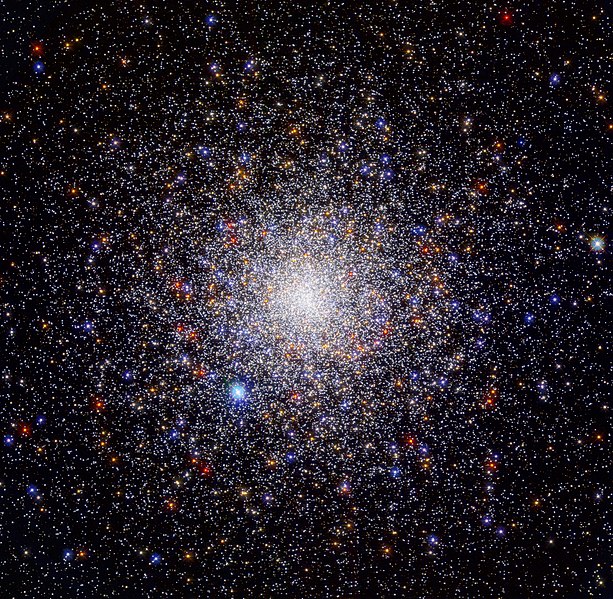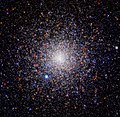File:Caldwell 73 (50291856937).jpg

Original file (2,666 × 2,607 pixels, file size: 6.67 MB, MIME type: image/jpeg)
Captions
Captions
Summary[edit]
| DescriptionCaldwell 73 (50291856937).jpg |
Caldwell 73, or NGC 1851, was discovered by the Scottish astronomer James Dunlop in 1826. It is located roughly 40,000 light-years from Earth in the constellation Columba and has an apparent magnitude of 7.3. This dense globular cluster can be spotted through a pair of binoculars, appearing as a fuzzy patch of light. Small telescopes will resolve some of the cluster’s individual stars, away from its compact center. Caldwell 73 is easiest to view from equatorial latitudes in the Northern Hemisphere during the winter and from the Southern Hemisphere during the summer. The stars in many known globular clusters are about the same age, indicating that the stars formed at roughly the same time. However, observations of Caldwell 73 reveal that it hosts stellar populations with different ages. The cluster is also encircled by a diffuse halo of stars. Although the origins of the halo and multiple star populations are unknown, one idea is that Caldwell 73 is a remnant of two clusters that collided within a dwarf galaxy that once hosted them both. When the clusters merged, the outer regions of the host galaxy may have been stripped away via interactions with more massive galaxies, leaving only the stellar nucleus and halo behind. This image of Caldwell 73 was captured by Hubble’s Wide Field Camera 3. It is a composite of multiple observations taken at ultraviolet and visible wavelengths. The observations were taken to help astronomers better understand why some globular clusters appear to play host to multiple generations of stars. A bright, blue, giant star appears to the lower left of center. Credit: NASA, ESA, and G. Piotto (Università degli Studi di Padova); Processing: Gladys Kober (NASA/Catholic University of America) For Hubble's Caldwell catalog website and information on how to find these objects in the night sky, visit: <a href="https://www.nasa.gov/content/goddard/hubble-s-caldwell-catalog" rel="noreferrer nofollow">www.nasa.gov/content/goddard/hubble-s-caldwell-catalog</a> |
| Date | |
| Source | Caldwell 73 |
| Author | NASA Hubble Space Telescope |
Licensing[edit]
- You are free:
- to share – to copy, distribute and transmit the work
- to remix – to adapt the work
- Under the following conditions:
- attribution – You must give appropriate credit, provide a link to the license, and indicate if changes were made. You may do so in any reasonable manner, but not in any way that suggests the licensor endorses you or your use.
| This image was originally posted to Flickr by NASA Hubble at https://flickr.com/photos/144614754@N02/50291856937. It was reviewed on 16 December 2020 by FlickreviewR 2 and was confirmed to be licensed under the terms of the cc-by-2.0. |
16 December 2020
File history
Click on a date/time to view the file as it appeared at that time.
| Date/Time | Thumbnail | Dimensions | User | Comment | |
|---|---|---|---|---|---|
| current | 17:44, 16 December 2020 |  | 2,666 × 2,607 (6.67 MB) | Szczureq (talk | contribs) | Transferred from Flickr via #flickr2commons |
You cannot overwrite this file.
File usage on Commons
There are no pages that use this file.
File usage on other wikis
The following other wikis use this file:
- Usage on en.wikipedia.org
- Usage on es.wikipedia.org
- Usage on fa.wikipedia.org
- Usage on ja.wikipedia.org
- Usage on pl.wikipedia.org
Metadata
This file contains additional information such as Exif metadata which may have been added by the digital camera, scanner, or software program used to create or digitize it. If the file has been modified from its original state, some details such as the timestamp may not fully reflect those of the original file. The timestamp is only as accurate as the clock in the camera, and it may be completely wrong.
| Orientation | Normal |
|---|---|
| Horizontal resolution | 72 dpi |
| Vertical resolution | 72 dpi |
| Software used | Adobe Photoshop 21.2 (Macintosh) |
| File change date and time | 15:46, 14 August 2020 |
| Y and C positioning | Centered |
| Exif version | 2.32 |
| Date and time of digitizing | 17:47, 9 April 2019 |
| Meaning of each component |
|
| Supported Flashpix version | 1 |
| Color space | sRGB |
| Bits per component |
|
| Compression scheme | Uncompressed |
| Height | 2,607 px |
| Width | 2,666 px |
| Pixel composition | RGB |
| Number of components | 3 |
| Date metadata was last modified | 11:46, 14 August 2020 |
| Unique ID of original document | xmp.did:af2f0274-7045-43ad-ad03-06c951fdc7e6 |